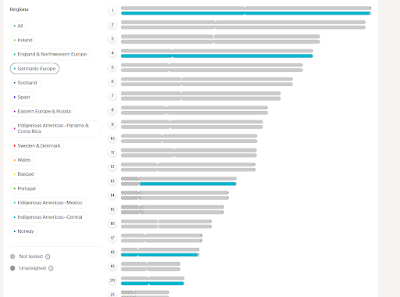I thought I was hallucinating when I saw a chromosome browser at AncestryDNA. They now have a beta ethnicity chromosome browser.
With the new browser we can now compare these ethnicity results with 23&me. At AncestryDNA you can select their parent 1 and parent 2 phased results to display an ethnicity browser showing what you inherited from each parent.
Since each company has their own ethnicity categories it's a little tricky.
I actually decided to look at the Sweden Denmark chromosomes from Ancestry first. I have no Scandinavian or Danish results at 23&me. I have no one from these ethnic groups on my family tree going back 7 and more generations. What does 23&Me tell me about chromosome 3 and 8? Part of chr 3 is likely French Canadian as I will explain later.
23&Me doesn't allow you to select a phased parent to display inherited ethnicity but I can figure out how they phased the results because my mother had indigenous roots and my father didn't. I know the top line of each chromosome is my mother and the bottom is my father. Looking at chromosome 3 23&me is speculating a segment in the same place as Ancestry is British and Irish instead of Swedish and Danish (I believe this is a French Canadian region on the chromosome as I explain later).
Chromosome 8 is split between broadly Northwest European and Eastern European. Sounds like a portion of chromosome 8 is difficult to place in a category.
Eastern European makes a lot of sense because my paternal grandfather was Austro-Hungarian. Chromosome 8 might be difficult to place because it likely represents my paternal grandfather who, being from the Austro-Hungarian empire, had a very mixed Eastern European heritage.
23&Me combines French and German in their predictions. I'm guessing the segments from my paternal side are mainly German. I do have French Canadian ancestors but that line is farther back. The German segment on chromosome 9 is being attributed to my mother's side. She did have German ancestors also. AncestryDNA predicts this region of the chromosome is English and Northwest European. I will look at the ethnicity of matches in that region.
AncestryDNA has an Eastern European Russian category which can be compared with Eastern European at 23&Me. My paternal grandfather was born near Graz, Austria. His family was originally from what is now Burgenland, Austria, today, but used to be Vas, Hungary before WWI.
AncestryDNA and 23&Me's results seem to line up fairly well when comparing Eastern European predictions.
23&Me predicts I have more Eastern European segments. They both agree chromosome 11 is from my paternal line and is all Eastern European.
Spanish has always been difficult for the companies to separate out. When I first got my results back, years ago, I had no Spanish admixture. My grandmother Graciela del Castillo was from Nicaragua and definitely has some Spanish ancestry.
AncestryDNA separates Spanish and Portuguese but 23&Me doesn't so I displayed Spanish and Portuguese by selecting both at Ancestry.
23&Me is giving me Spanish segments on both paternal and maternal lines. I only have Spanish descent on my mother's side, as far as I know.
British, Irish, and Scottish are much more complicated to compare because I have substantial ethnicity from these ethnic groups on both sides. I'm not even trying to figure that out.
I was not able to compare on a continental level with Europe but I could regarding Indigenous American. Comparing at that level the results are much more identical.
To compare the indigenous results between AncestryDNA and 23&Me I had to select more than one category at Ancestry, that's why the colors are different. Here we see 23&Me segments on the left and AncestryDNA on the right. 23&Me segments are hard to see because the color is so light but they do match up well with AncestryDNA's segments.
Neither company has been able to find my French. It's completely missing. I have French Canadian DNA matches on my Mason/Masson side. Segments in the regions below are from my French Canadian matches and should be identified as French Canadian. AncestryDNA misidentified this region on chr 3 as Swedish and Danish. The Normans did occupy part of France so this makes some sense. There are even more segments that are French Canadian not shown below. We need more French samples but testing in France is illegal so we aren't likely to see enough French results to assist with identification of the segments.
AncestryDNA is moving in the right direction by offering this useful tool. If they offered an opt-in matching segment browser I would highly recommend AncestryDNA as the very best place to test. We hope one chromosome browser leads to another.














No comments:
Post a Comment